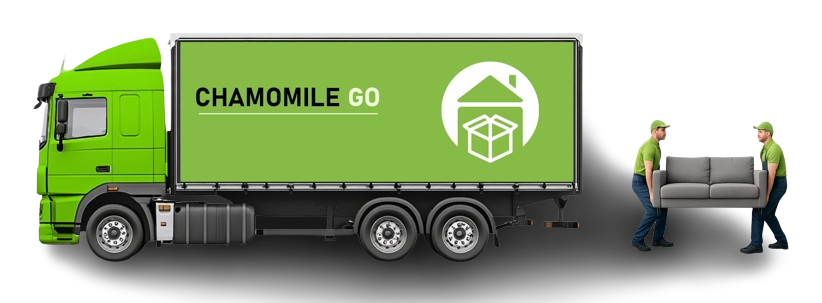Moving can be both thrilling and stressful, but the real difficulty arises when your new location is far away. What constitutes a long-distance migration is a question that many individuals have. It’s not always as easy as traveling a few miles or spending hours on the road.
Regardless of how far away their new residence may be, Chamomile Go has assisted thousands of clients in moving safely and smoothly. Knowing the difference between a local and long-distance relocation is essential for budgeting, planning, and preventing unpleasant surprises on moving day, regardless of whether you’re moving a few hundred miles or to a different state. Let’s go over all you need to know about what is considered a long distance move, how to get ready, and how to smoothly transition with professional advice.
Understanding a Long Distance Move
What constitutes a long-distance move in the moving industry usually relies on how far you’re going and whether you’re crossing state lines.
Local Move: Usually inside the same state and 50–100 miles of where you are now.
Intrastate Move: Moving more than 100 miles within the same state borders is known as an intrastate move.
Interstate or Long Distance Move: Moving over state borders or more than 400 miles, even within the same region, is referred to as an interstate or long-distance move.
Moving over state lines or more than a few hundred miles is generally considered moving long distance while each moving business has its own mileage criteria.
Average Distance and Time for a Long-Distance Move
Depending on whether you’re moving across the nation or within the same state, the majority of long-distance relocation fall between 400 and 3,000 miles.
Example:
- Moving from Denver to Dallas, which is around 800 miles apart, is regarded as a long distance.
- A cross-country move would be from New York to Los Angeles, which is around 2,800 miles away.
- Moving long distance typically takes two to seven days from pickup to delivery, though this varies depending on the route, weather and logistics.
You may read Long Distance Moving Tips?
Factor Determining Long Distance Move Costs
There are other factors besides distance that affect move costs. The following are the main variables that affect pricing:
Total Distance
Naturally, the cost of fuel, labor and time increases with distance traveled. Relocating across borders might cost two to three times as much as moving within a state.
Belonging Weight
The final cost is strongly impacted by the overall weight of your cargo. Larger trucks and more gasoline are needed for heavier loads.
Transportation Services
Packing, loading, storing and unpacking are examples of full-service services that improve convenience but also increase overall costs.
Demand by Season
Since summer is the busiest time of year for relocating, prices are usually higher. You can save hundreds of dollars by planning your move for off-peak months.
Availability
The process may take more time and effort in homes with small parking spaces, narrow streets, or tiny staircases.
Liability and Insurance
Additional insurance coverage is typically required for long-distance relocation in order to safeguard assets throughout the trip.
Timeline Movement
Since movers can plan routes more effectively when you have flexible moving dates, Chamomile Go helps consumers save money.
How to Prepare Your Long Distance Move Checklist
Relocating can be stressful or easy depending on how well-prepared you are. To help you with the process, below is a detailed long distance move checklist:
- Start Early: At least eight to twelve weeks prior to your moving date, start making arrangements.
- Make an inventory: To prevent confusion later, make a list of everything you are taking.
- Declutter: To lower the weight of your shipment, sell, donate or throw away any goods you no longer need.
- Obtain Several Quotes: Examine moving firms for value and openness.
- Schedule Movers Ahead of Time: During peak months, reputable providers like Chamomile Go quickly fill up.
- Clearly Label Boxes: To make unpacking easier, label each box by room and contents.
- Keep Essentials Separate: Put valuables, prescription drugs and vital documents in a travel bag.
- Verify Specifics: A few days prior to the relocation day, confirm the collection and delivery dates.
You can stay organized during the entire process and avoid missing any crucial procedures by using a long-distance move checklist.
Expert Tips for Planning a Long Distance Move
Efficiency and vision are crucial when planning a long distance move. The following are some professional tactics from Chamomile Go to improve your experience:
- Investigate Regulations: Be aware of the various insurance and transportation laws in each state beforehand.
- Pack Wisely: For lengthy trips, choose sturdy fabrics and carefully wrap delicate goods.
- Be Adaptable: Add extra time to your schedule in case of minor delays due to weather or logistics.
- Use Tracking: For peace of mind, trustworthy businesses like Chamomile Go provide GPS tracking.
- Get Ready for Unpacking: To ensure a comfortable first night, arrange necessities like bedding, toiletries and kitchenware first.
You may reduce stress, save money and move into your new house more quickly if you carefully plan your long-distance relocation.
Final Thoughts
You can spend wisely and prepare with confidence now that you know what counts as a long-distance move. Every relocation has its challenges, but with the right team and careful planning, your experience can be smooth and stress-free. At Chamomile Go, we combine experience, care, and reliability to make every mile of your move effortless.
Whether you’re relocating across the state or across the country, our expert movers in Sherman Oaks are ready to guide you every step of the way. From detailed checklists to personalized moving plans, we ensure your transition is seamless from start to finish. Ready to move with confidence? Contact Chamomile Go today to get a free quote and discover why homeowners and businesses trust our Sherman Oaks movers for long-distance relocations done right.
FAQs
1. What distance qualifies as a long-distance move?
Moving more than 400 miles or across state lines is typically considered a long-distance relocation.
2. How long does moving long distance take?
Depending on the route, distance and weather it usually takes two to seven days.
3. What should I include in my long distance move checklist?
Packing, making inventory, hiring movers, labeling boxes and verifying delivery dates should all be on your checklist.
4. How do I start planning a long distance move efficiently?
To save time and money, start early, look up reliable movers like Chamomile Go and declutter before packing.
5. Does Chamomile Go handle interstate relocations?
Yes, we provide dependable transportation, packing, and storage services across the country and specialize in both local and interstate relocation.




